|
|||||||||
|
|||||||||
|
|
|
|
|
|
|
|
|
|
|
|
|
|
|
|
|
Antiques
Jump To:
Barometer | Clock | Mirror | Organ | Silvered Glass | General References
Barometers
Description: Mercurial barometers were first invented in the 1640s. Most antique barometers found today are those dating back to the 18th and 19th centuries. These are generally refurbished and sold to collectors. A mercury barometer consists of a glass tube that is closed at one end with a mercury-filled reservoir at the base. There are many different styles of antique barometers (e.g., stick, wheel, or dial) that may contain elemental mercury in the glass tube or as an attached thermometer. Most of these are sealed systems in which no liquid mercury can escape, even when the barometer is inverted; however some antique barometers do have one end that is open to the atmosphere.
The exact amount of mercury depends on the style and size of the barometer.
 |
| Click image for a larger view Source: eBay, (antique wheel barometer) |
Purpose of the Mercury: A barometer is an instrument used to measure atmospheric pressure. The level of mercury in the barometer rises or falls with changes in pressure, corresponding to a change in the weather pattern. Non-mercury barometers exist (e.g., aneroid, digital, and liquid gas silicon), that are both accurate and attractive; however, there is still an interest among collectors in the antique barometers that contain the shiny, silver-colored elemental mercury.
Potential Hazards: The amount of mercury contained in barometers, combined with the fact that some may have an "open-system" (i.e., one end of the glass tube containing the mercury is open), creates a high potential for a mercury release or spill. Spills greater than one pound of elemental mercury (about two tablespoons) must be reported to the appropriate state environmental agency. Persons that have been exposed to a mercury spill should contact the public health department or poison control center.
Recycling/Disposal: Households are generally exempt from the RCRA hazardous waste requirements. However, because of the amount of mercury in barometers, they are prohibited from being disposed of in landfills and must be managed as hazardous waste. Many states offer household hazardous waste collection programs for recycling and disposal of mercury-containing items, including household barometers. Some states and municipalities provide this service free of charge, while others require a small fee. Persons should first check with their local municipality to find out about the specific recycling and disposal options (including which products are accepted).
Licensed hazardous waste management firms may also collect, transport, and recycle mercury from the barometers. Some antique dealers will purchase antique mercury barometers to restore and refurbish and offer them for re-sale. As noted, antique barometers are fairly expensive; therefore, the likelihood that someone would dispose of one by throwing it in regular trash is relatively slim.
Persons should never attempt to drain or replace mercury from a barometer on their own. Care should be taken when packing barometers for shipment or disposal in order to prevent breakage and to contain a possible mercury release. If a leak or break occurs, persons should immediately contact their state environmental agency for instructions on proper clean-up and disposal. They should contact their public health department or poison control center if they have been exposed to the mercury.
 |
| Click image for a larger view Source: NEWMOA, (close-up of mercury in a scientific barometer) |
- Connecticut: Antique mercury-added products, including barometers, may be exempt from the sales prohibition and labeling requirements, if the seller provides documentation showing that the product was manufactured prior to January 1, 2004. (HB 6567; Connecticut General Statutes Part 22a-623b)
- Maine: The sale of antiques and other used products is exempt from Maine?s ban of the sale of mercury instruments and measuring devices. (MRSA Title 38, section 1661-C, subsections 6 and 10)
- Massachusetts: Antique barometers, including those with attached mercury thermometers, manufactured before 1955 are exempt from the sales prohibition. (Proposed SB 2555)
- New York: Re-sale of barometers manufactured before December 31, 2005 are exempt from the sales prohibition. (Mercury-Added Consumer Products Law Part 27-2107)
- Vermont: Barometers may not be offered for final sale, sold at a final sale, or distributed in Vermont as a new manufactured product. Because the word "new" is specified in this law, antique barometers are exempt from the sales prohibition. (Comprehensive Mercury Management Law Chapter 164, Part 7105, Subpart (e)(1)(A))
Related Link: http://www.charlesedwin.com/mercury.htm
Clocks
Description: Clocks that include a pendulum can contain mercury. They are sometimes referred to as a long-case, tall-case, or grandfather clock. The pendulum is a weight that swings at precisely timed intervals, keeping an accurate time on the clock face. Many of the early- to mid- 17th century clocks used liquid mercury as the pendulum weight.
Purpose of the Mercury: The mercury in antique clocks is contained in the pendulum and acts as a weight. The weighted pendulum is designed to keep the center of oscillation constant, so that each "swing" (i.e., rotation) corresponds
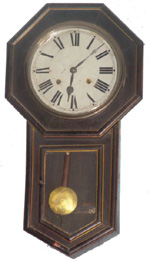 |
| Click image for a larger view Source: Wikipedia, (antique pendulum clock) |
Potential Hazards: Antiques become more fragile as they age, which increases the risk of spills from breakage when the items are damaged, dropped, or moved improperly. Wall-mounted clocks and free-standing clocks both have the potential to fall and break, possibly causing the pendulum to break and release mercury. If a leak or break occurs, persons should immediately contact their state environmental agency for instructions on proper clean-up and disposal. They should contact their public health department or poison control center if they have been exposed to the mercury.
Recycling/Disposal: Many states offer household hazardous waste collection programs for recycling and disposal of mercury-containing items, including antique clocks. Some states and municipalities provide this service free of charge, while others require a small fee. Persons should first check with their local municipality to find out about the specific recycling and disposal options (including which products are accepted).
 |
| Click image for a larger view Source: New York State Department of Health (NYS DOH)) |
 |
| Click image for a larger view Source: Wikipedia, (antique grandfather clock) |
Statutes and Other Information: Although there may not be any regulations specifically identifying antique clocks as a mercury-added product that is banned from sale, in some states, including Connecticut, Louisiana, and Rhode Island, the amount of mercury they contain (greater than one gram) would prohibit them from being sold. However, because of the difficultly in regulating antiques, many antique dealers continue to sell them in stores and online. Some states, including Connecticut, offer a specific exemption for antiques containing mercury.
Mirrors
Description: Most 16th century mirrors, including mirrors attached to antique dressers, were likely produced using a liquid mercury amalgam. The mercury is actually contained in the reflective layer behind the glass portion of the mirror. Other types of antique mirrors that contain mercury include "silvered" mirrors and tin mirrors. Mirror makers stopped using mercury in the 1840s, instead switching to silver nitrate, which is still used today.
Purpose of the Mercury: During the 16th century, liquid metals were used in the production of mirrors. The method involved backing a sheet of flat glass with a thin layer of reflecting metal. The metal used for this reflecting layer was an amalgam consisting of approximately 25 percent mercury and 75 percent tin.
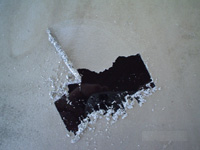 |
| Click image for a larger view Source: Elemental Services & Consulting Inc. (ESCO), (mercury amalgam scraped off the back of a mirror) |
Potential Hazards: Antique mirrors are surprisingly well-preserved, with the amalgamated mercury not usually a concern. However, when resurfacing an antique mirror, workers should take proper precautions to avoid inhaling mercury vapor.
Extra care should be taken when cleaning up a broken mirror that contains mercury. Persons should always wear gloves and place the broken pieces of glass and mercury amalgam in a puncture-resistant container with a sealed lid for hazardous waste disposal. If a break does occur, it is likely that the mercury vapor concentrations emitted from the mirror amalgam "flakes" would exceed safe indoor air levels. Persons should immediately contact their state environmental agency for instructions on proper clean-up and disposal. They should contact their public health department or poison control center if they have been exposed to the mercury.
Recycling/Disposal: Many states offer household hazardous waste collection programs for recycling and disposal of mercury-containing items, including antique mirrors. Some states and municipalities provide this service free of charge, while others require a small fee. Persons should first check with their local municipality to find out about the specific recycling and disposal options (including which products are accepted).
Persons should not attempt to remove the mirror if it is attached to a piece of furniture. If the mirror were to break, any wastes associated with that break, including the glass and clean-up materials, would need to be disposed of as hazardous waste.
Statutes and Other Information: Although there may not be any regulations specifically identifying antique mirrors as a mercury-added product that is banned from sale, in some states, including Connecticut, Louisiana, and Rhode Island, the amount of mercury they contain (greater than one gram) would prohibit them from being sold. However, because of the difficultly in regulating antiques, many antique dealers continue to sell these mirrors in stores and online regardless of state mercury-added products laws. Some states, including Connecticut, offer a specific exemption for antiques containing mercury.
Related Link:
http://www.p2pays.org/ref/38/37983.pdf
Organs
Description: An organ is a musical instrument that produces a sound when air is moved through pipes. Antique organs, including pipe organs commonly found in churches, usually contain a mercury switch or manometer used to regulate the air pressure and produce a constant, harmonious sound. These parts comprise the organ?s "wind system," which produces, stores, and delivers the air to the pipes. Such switches and manometers may contain substantial amounts of mercury.
Purpose of the Mercury: In most organs, the manometer is connected to the bellows. This manometer regulates the pressure of air as it is sent from the bellows, causing the reeds to vibrate and make a sound. The vibrations coming through the individual pipes are blended to create a harmonious sound, which makes the music emitted from pipe organs different than that produced from electronic organs. The mercury tilt switches contained in organs are usually the on-off switches that are used for main chorus reverb.
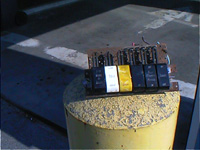 |
| Click image for a larger view Source: Maine Dept. of Environmental Protection, (mercury switches removed from pipe organ) |
Potential Hazards: As long as the organ remains intact, there is a low probability that there would be a mercury release. However, because they may contain a substantial quantity of mercury in the manometer or within multiple switches, breakage may result in significant spillage, high levels of mercury vapor in the air, and costly cleanup.
Recycling/Disposal: Mercury manometers and/or tilt switches should be removed from the organ prior to disposal. However, persons should never attempt to do this on their own. Rather, they should bring the intact organ to a waste facility, which is equipped to safely remove the mercury and that will send it to a mercury recycler for reclamation.
Once the mercury is removed, the organ pipes may be melted down for reuse and other ornamental parts or materials may be taken off and sold. Then the left-over scraps of the organ can be disposed of as solid waste.
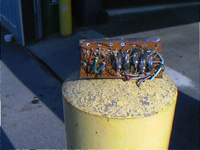 |
| Click image for a larger view Source: Maine Dept. of Environmental Protection, (mercury tilt switches removed from pipe organ) |
Statutes and Other Information: In many states, including California, Maine, Massachusetts, Minnesota, and New York, measuring devices, such as manometers are among the list of mercury-added products that are prohibited for sale. Please note that the types of manometers that would be found in a pipe organ are used for measuring the pressure of air - these manometers are defined separately from dairy manometers, which may be subject to different state regulations.
In other states, including California, Connecticut, Illinois, Louisiana, Maine, Massachusetts, Minnesota, New Hampshire, New York, Rhode Island, and Vermont, mercury tilt switches are among the list of mercury-added products that are prohibited for sale - whether they are sold alone or as components of another product.
Many of the states that ban the sale of these mercury products or components do allow manufacturers of these products to apply for an exemption for selling replacement components, which, if approved, would allow them to sell these components in the state after the effective phase-out date. Some states provide a specific sales exemption for antiques containing mercury components as integral part of the product, such as organs that contain mercury switches. Some of the states? "blanket" sales ban exemptions are summarized below:
- California: A mercury switch used to replace a switch that is a component of a larger product in use prior to July 1, 2006 and that is integrated in and not physically separate from other components of the larger product is exempt from the sales prohibition.(Health and Safety Code section 25214.8.4(b))
- Illinois: Replacement switches and relays for a product in use prior to July 1, 2007 and that are not physically separate from other components in the larger product are exempt from the sales prohibition. (Public Act 093-0964)
- Maine: The sales prohibition does not apply to antiques and other used products. However if the units in service prior to July 1, 2006 are being repaired using a new mercury switch or relay, the sale of those replacement parts would be covered if these parts are not considered integrated and not physically separate from the units. Replacement of the manometer with a new manometer would also need to have an exemption filed unless the use of the unit is covered by a federal requirement. (MRSA Title 38, section 1661-C, subsections 7 and 10)
- Massachusetts: A mercury switch or relay that is integrated as a component of a larger product that has been refurbished for resale and which was originally manufactured before the effective date of the law (May 1, 2009) is exempt from the sales prohibition.(SB 2464; "An Act Relevant to Mercury Management" Section 6E)
- New Hampshire: The sales prohibition does not apply if the mercury switch, relay, or thermostat is used to replace a switch, relay, or thermostat that is a component in a larger product in use prior to July 1, 2008 provided that no compatible non-mercury replacement component exists.("Mercury-Added Product Restrictions" RSA 149-M:53 part V.(a))
- New York: The mercury manometer sales prohibition does not apply if the mercury manometer is used to replace a manometer that is a component in a larger product in use prior to January 1, 2007. The mercury switch sales prohibition does not apply if the mercury switch is used to replace a switch that is a component in a larger product in use prior to January 1, 2008.(Title 21 Mercury-added Consumer Products Law Section 27-2107, Subparts 6 and 7)
Silvered Glass
Description: "Silvered" glass, also known as mercury glass, is glass blown double walled, then silvered between the layers with a liquid silvering solution, and sealed. The process involves coating the glass with a reflective substance - an amalgam of precious metals, that could include silver, gold, tin, and mercury. Vases, goblets, decorative tableware, lamps, candlesticks, and novelty items, such as statues, figurines, and ornaments were often made with silvered glass and decorated by painting, enameling, etching, and engraving. Silvered glass items were made for display and for artistic value, rather than for utilitarian use.
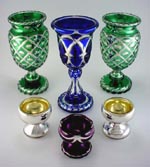 |
| Click image for a larger view Source: Wikipedia, (antique silvered glass objects) |
Silvered glass was produced as early as 1825 in the glassmaking regions of Eastern Europe. Mercury was only used in the production silvered glass prior to the 1850s.
Purpose of the Mercury: Early pieces of silvered glass used mercury amalgams, based on the same technique used for silvering mirrors. The reflective qualities of mercury amalgam provided the glass surface a mirror-like silvery shine. However, mercury amalgams proved to be unsuitable for glassmaking. Mercury left a distorted reflection in the glass, was toxic to the glass blowers, and was too expensive to be practical. By the late 1840s and 1850s, manufacturers of silvered glass were using a silver nitrate and glucose solution instead of the mercury amalgam.
While some glass pieces may include a date stamped on the bottom, it is often difficult to tell the difference between antique silvered glassware produced using mercury amalgam and those produced with silver nitrate. Antique experts may be able to date the glass.
Potential Hazards: Extra care should be taken when cleaning up broken glass that may contain mercury. Persons should always wear gloves and place the broken pieces of glass in a puncture-resistant container with a sealed lid for hazardous waste disposal. Persons should contact their state environmental agency for instructions on proper clean-up and disposal and public health department or poison control center if they have been exposed to the mercury amalgam.
Recycling/Disposal: Some states, including Massachusetts, Maine, Minnesota, New York, Rhode Island, and Vermont prohibit the disposal of mercury-added products in municipal solid waste. These items must be managed and disposed of as a hazardous or universal waste, or properly recycled.
Persons should not recycle antique glassware with their regular glass recycling. Many states offer household hazardous waste collection programs for recycling and disposal of mercury-containing items, including antique glass. Some states and municipalities provide this service free of charge, while others require a small fee. Persons should first check with their local municipality to find out about the specific recycling and disposal options (including which products are accepted).
Some antique collectors seek out silvered glass vessels. Items that are made of this glass, including vases, goblets, candlesticks, and other pieces of glassware, are considered to be a valuable collector?s item, since they are very old and rare. Antique dealers may purchase items made of antique silvered or mercury glass to restore and refurbish and offer them for re-sale.
Statutes and Other Information: Although there may not be any regulations specifically identifying antique glass as a mercury-added product that is banned from sale, in some states, including Connecticut, Louisiana, and Rhode Island, the amount of mercury they contain (greater than one gram) would prohibit them from being sold. However, because of the difficultly in regulating the sales of antiques, many antique dealers continue to sell silvered glass items in stores and online regardless of state mercury-added products laws. Some states, including Connecticut, offer a specific exemption for antiques containing mercury.
Production of silvered glass declined around the 1900s, and became obsolete (it was time consuming to make and costly to produce). In the 1970s, contemporary glass artists rediscovered the use of silvering for decorative purposes and incorporated it into their work. Today, silvering solution kits that utilize powdered aluminum can be purchased to replicate the silvering process - these kits do not contain mercury amalgam.
Related Links:
http://www.glass.co.nz/mercury.html
General References
The links below are general references that provide information pertaining to all mercury-containing antiques:
Hazards Resulting from Mercury Antiques:
http://www.cdc.gov/mmwr/preview/mmwrhtml/mm5623a2.htm
Mercury Product Phase-outs, Sales Prohibitions, and Exemptions:
http://www.newmoa.org/prevention/mercury/imerc/banphaseout.cfm
Spill Clean-up Guidance:
http://www.mass.gov/eea/agencies/massdep/toxics/sources/cleaning-up-elemental-mercury-spills.html
Last Modified 08/25/2020
Home
|
Pollution Prevention
|
Mercury
|
IMERC
|
Solid Waste
Hazardous Waste
|
Waste Site Cleanup
|
About NEWMOA
|
NEWMOA Members
Copyright 2025 NEWMOA, Northeast Waste Management Officials' Association
89 South Street, Suite 600; Boston, MA 02111-2651;
ph (617) 367-8558
fax (617) 367-0449
TDD/TTY (857) 265-3934
All Rights Reserved
Comments contact:
.
